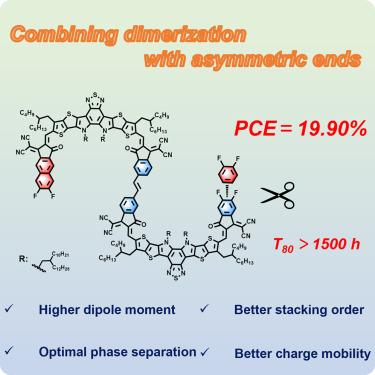Precise heterodimerization of acceptors for high-efficiency binary organic solar cells
IF 17.5
1区 材料科学
Q1 MATERIALS SCIENCE, MULTIDISCIPLINARY
引用次数: 0
Abstract
Although dimeric acceptors have demonstrated promising efficacy for improving operational stability of organic solar cells (OSCs), the power conversion efficiencies (PCEs) of corresponding binary devices remain constrained due to their weak intermolecular interactions and undesirable molecular packing. Here, we integrate a dimerization with asymmetric terminal strategy to design a heterodimer acceptor, NVB. Breaking molecular symmetry enhances dipole interactions and optimizes molecular packing, leading to superior charge transport and suppressed recombination. As a result, the PM6:NVB-based device achieves a record-high efficiency of 19.90% (certified as 19.35%), representing the highest value reported for all dimer-based binary devices thus far. Remarkably, the NVB-based device exhibits enhanced stability with a T80 (lifetime for maintaining 80% of its initial efficiency) over 1,500 h, attributed to elevated glass transition temperature (Tg). Overall, this work establishes an “asymmetric dimerization” paradigm that concurrently improves efficiency and stability through molecular engineering, providing a practical pathway toward high-performance OSCs.

高效二元有机太阳能电池受体的精确异二聚化
尽管二聚体受体在提高有机太阳能电池(OSCs)的运行稳定性方面表现出了良好的效果,但由于其分子间相互作用弱和不良的分子堆积,相应的二元器件的功率转换效率(pce)仍然受到限制。在这里,我们将二聚化与不对称末端策略相结合,设计了一个异二聚体受体NVB。打破分子对称增强偶极相互作用和优化分子堆积,导致优越的电荷传输和抑制重组。因此,基于PM6: nvb的器件实现了19.90%(认证为19.35%)的创纪录高效率,代表了迄今为止所有基于二聚体的二进制器件所报告的最高值。值得注意的是,由于玻璃化转变温度(Tg)升高,基于nvb的器件表现出更高的稳定性,T80(保持80%初始效率的寿命)超过1500小时。总的来说,这项工作建立了一种“不对称二聚化”模式,通过分子工程同时提高了效率和稳定性,为高性能osc提供了一条实用的途径。
本文章由计算机程序翻译,如有差异,请以英文原文为准。
求助全文
约1分钟内获得全文
求助全文
来源期刊

Matter
MATERIALS SCIENCE, MULTIDISCIPLINARY-
CiteScore
26.30
自引率
2.60%
发文量
367
期刊介绍:
Matter, a monthly journal affiliated with Cell, spans the broad field of materials science from nano to macro levels,covering fundamentals to applications. Embracing groundbreaking technologies,it includes full-length research articles,reviews, perspectives,previews, opinions, personnel stories, and general editorial content.
Matter aims to be the primary resource for researchers in academia and industry, inspiring the next generation of materials scientists.
 求助内容:
求助内容: 应助结果提醒方式:
应助结果提醒方式:


